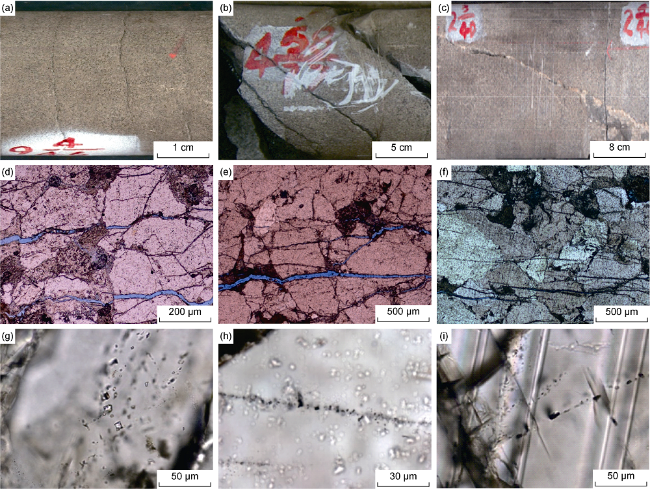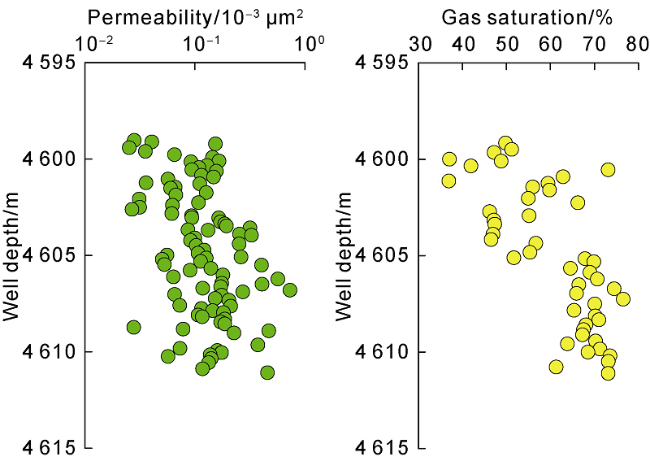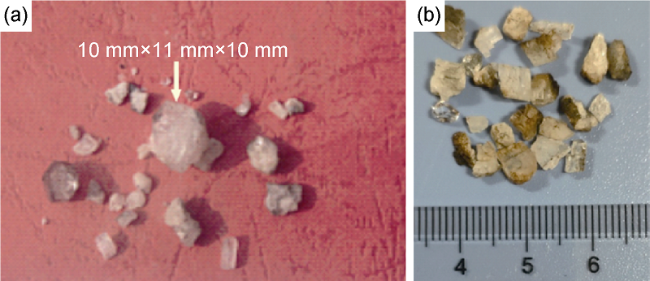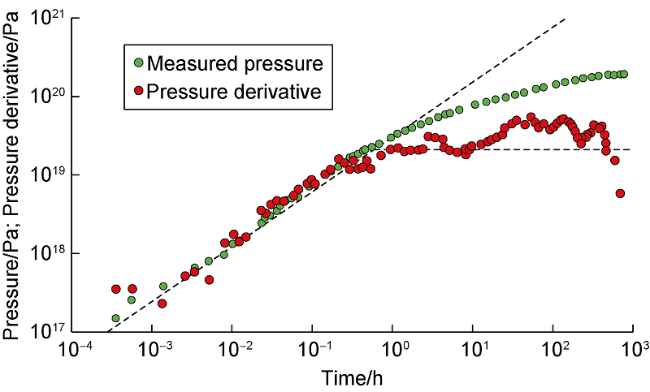Introduction
1. Accumulation of carrier-bed shale gas
Fig. 1. Study areas and bottom structure maps of target horizons. (a) Tectonic units and study areas in Sichuan Basin; (b) Bottom structure map of the Qiongzhusi Formation in Jingyan-Qianwei area; (c) Bottom structure map of the second member of Xujiahe Formation in Xinchang structural zone in Western Sichuan depression. |
Table 1. Comparison of characteristics between Qiongzhusi Formation and Longmaxi Formation |
| Formation | Sedimentary setting | Sequence | Microfacies | Formation thickness with TOC >3%/m | Formation thickness with TOC >2%/m | Mineral composition/% | Clay composition/% | Porosity/ % | Pore composition/ % | Pore volume/ (mL·g-1) | Gas content/ (m3·t-1) |
|---|---|---|---|---|---|---|---|---|---|---|---|
| Qiongzhusi Formation (Jingyan- Qianwei area) | Intracratonic sag | 3 cycles and 3 sets of shale | Deep-water muddy shelf | 0 | 2-3 | Low content of calcium (5%), high content of silica (70%) | Illite, 46%; I/S, 40% | 2-4 | Organic pores 15%; minor brittle mineral pores; clay mineral pores, 84% | 0.006 | 0.6-2.3 |
| Longmaxi Formation (Weiyuan area) | Craton | 1 cycle and 1 set of shale | Deep-water siliceous and calcium-siliceous shelf | Continuous thickness of 7-10 m | Continuous thickness of 24-35 m | Medium content of calcium (15%), high content of silica (45%) | Illite, 34%; I/S, 61% | 6-8 | Organic pores, 65%; brittle mineral pores, 8%; clay mineral pores, 47% | 0.012 | 5-6 |
1.1. Sedimentary characteristics and types of shale
1.1.1. Sedimentary characteristics
Fig. 2. (a) Facies model of Qiongzhusi Formation in Sichuan Basin and (b) stratigraphic column of Qiongzhusi Formation in the study area. |
Fig. 3. Lithologic characteristics of Qiongzhusi Formation. (a) Well JS103, 3581.04-3581.20 m, black organic-rich siliceous shale with nodular pyrite in Layer ①; (b) Well JS103, 3522.20-3522.42 m, dark gray calcareous silty shale interbedded with gray calcareous argillaceous siltstone in Layer ④; (c) Well JS103, 3371.00-3371.22 m, dark gray argillaceous silty shale with laminae in Layer ⑦; (d) Well JS103, 3359.19-3359.40 m, massive gray siliceous silty shale with laminae in Layer ⑦; (e) Well JS103, 3313.94-3314.12 m, dark gray argillaceous shale in Layer ⑩; (f) Well JSH1, 3384.03 m, black organic-rich siliceous shale with calcareous laminae in Layer ①; (g) Well JS103, 3520.50 m, dark gray calcareous silty tight shale with obvious calcite-cemented laminae in Layer ④; (h) Well JS103, 3371.36 m, gray argillaceous silty shale with laminae in Layer ⑦; (i) Well JS103, 3359.03 m, gray siliceous silty shale with even silt distribution and silica content up to 65%-70% in Layer ⑦; (j) Well JS103, 3313.44 m, ash black argillaceous shale with calcareous carbonate-cemented laminae in Layer ⑩. |
1.1.2. Types of shales
Table 2. Particle-size identification result of Qiongzhusi Formation in Well JS103 |
| Layer | Lithology | Depth/m | Particle size ratio/% | |
|---|---|---|---|---|
| Silt-sized | Mud-sized to silt-sized | |||
| Layer ⑦ | Silty shale | 3362.77 | 2.04 | 97.96 |
| Silty shale | 3363.93 | 100.00 | ||
| Silty shale | 3372.54 | 10.99 | 89.01 | |
| Silty shale | 3374.93 | 14.44 | 85.56 | |
1.2. Geochemical characteristics
Fig. 4. Longitudinal distribution of experiment parameters of Qiongzhusi Formation in Well JS103. |
1.3. Reservoirs
Fig. 5. Types of reservoir space within silty shales of Qiongzhusi Formation in Well JS103. (a) 3348.18 m, dissolution pores on surface of feldspar particles; (b) 3348.19 m, interlamellar pores and fractures of clay minerals; (c) 3349.80 m, organic pores and interlamellar pores and fractures of clay minerals; (d) 3349.80 m, intercrystalline pores of strawberry pyrite; (e) 3353.49 m, interlamellar pores of clay minerals; (f) 3357.90 m, shrinkage fractures at edges of stripped organic matters; (g) 3360.56 m, shrinkage fractures of clay minerals connected with microfractures; (h) 3362.76 m, interlamellar pores and fractures of clay minerals connected with microfractures; (i) 3367.39 m, organic matters filling mineral particles, with organic pores and shrinkage fractures. |
Fig. 6. Relation between TOC and porosity of silty shales in Qiongzhusi Formation. |
1.4. Gas content
1.5. Controlling factors for enrichment and high-yield
1.5.1. Enlightenment from old wells
1.5.2. Silty shales being both carrier beds and reservoirs
Fig. 7. Accumulation model of conventional gas and shale gas on both sides of intracratonic sag in Sichuan Basin. |
2. Accumulation and enrichment of carrier body tight sandstone gas
2.1. Effectiveness of source rocks
2.1.1. Source rocks
Fig. 8. Kerogen types in the Xu 2 Member and Xiaotangzi Formation of Western Sichuan depression. |
Fig. 9. TOC of Source rocks in the Xiaotangzi Formation and Xu 2 Member of Western Sichuan depression. |
Fig. 10. Maturity of source rocks in the Xu 2 Member and Xiaotangzi Formation of Western Sichuan depression. |
2.1.2. Evolution of hydrocarbon generation of source rocks
Fig. 11. Burial and thermal maturity history of the Xu 2 Member of Well X1 in Western Sichuan depression. |
2.1.3. Coupling characteristics of source-reservoir-pool
Fig. 12. Relationship between homogenization temperature and salinity of inclusions in Xu 2 Member in Western Sichuan depression. |
Fig. 13. Relationship between ln (C1/C2) and ln (C2/C3) of natural gas in Xu 2 Member of Western Sichuan depression (according to Ref. [45]). |
2.2. Efficiency of carrier bodies
2.2.1. Characteristics of carrier bodies
Fig. 14. Fracture characteristics of Xu 2 Member in Western Sichuan depression. (a) Well A12, 4814.63-4814.76 m, horizontal fractures; (b) Well S1, 4485.86-4486.26 m, oblique fractures; (c) Well S1, 4485.86-4486.26 m, high-angle fractures; (d) Well A8, 5009.00 m, oriented structural fractures, unfilled; (e) Well A12, 4828.44 m, unfilled fractures; (f) Well G4, 4892.41 m, particle crack; (g) Well F1, 4759.60 m, gaseous hydrocarbon inclusions distributed as bands along the microfissures of quartz grains; (h) Well G5, 4674.40 m, gaseous hydrocarbon inclusions distributed as bands along the microfissures through quartz grains; (i) Well F1, 4526.77 m, light grey hydrocarbon-bearing brine inclusions distributed as belts along the microfissures of calcite veins. |
2.2.2. Dominant migration pathways of oil and gas
Fig. 15. Vertical variation in permeability and gas saturation of sealed cores of Well S4 in Western Sichuan depression. |
2.3. Voluminosity of carrier bodies
2.3.1. Voluminosity of faults and fractures
Fig. 16. Secondary minerals filled in the fractures of Xu 2 Member in Western Sichuan depression. (a) Well S1, 4762- 4787 m, secondary quartz, semi-idiomorphic crystal - idiomorphic crystal; (b) Well S2, 4776-4778 m, secondary calcite, semi-idiomorphic crystal - idiomorphic crystal. |
2.3.2. Voluminosity of high- and low-permeability matrix reservoirs
Fig. 17. Pressure build-up curve of Xu 2 Member of Well S1 in Western Sichuan depression. |
2.4. Enrichment model
Fig. 18. High-yield enrichment model of tight sandstone gas reservoirs in Xujiahe Formation, Sichuan Basin. T3x3—third member of Xujiahe Formation; T3x2—second member of Xujiahe Formation; T3m+t—Maantang and Xiaotangzi formations. |



















